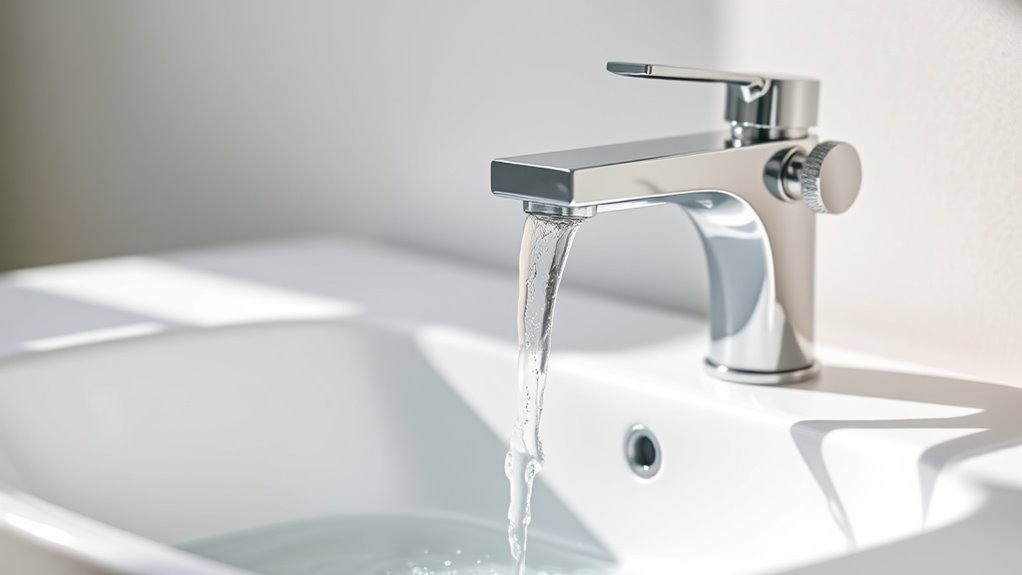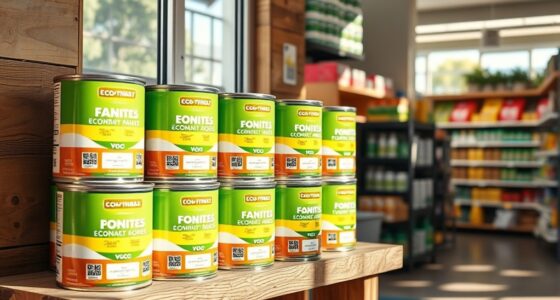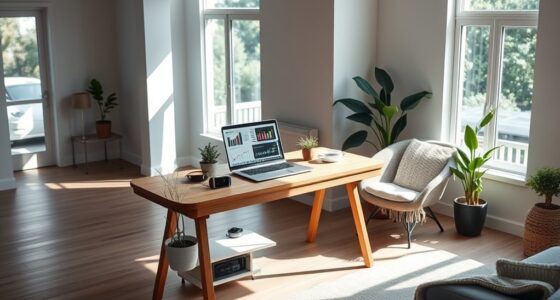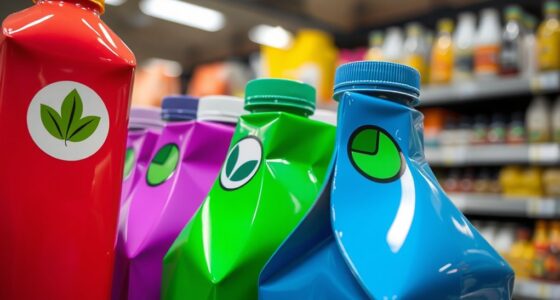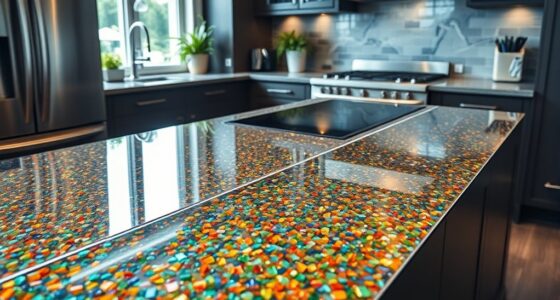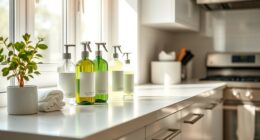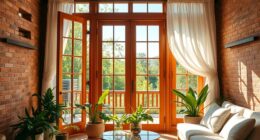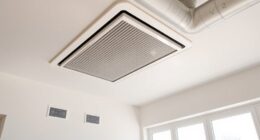Yes, low-flow fixtures really save water while still performing well. They use markedly less water—like showerheads dropping from 2.5 to 1.5 gallons per minute and toilets using up to 50% less. You’ll notice lower utility bills and help conserve resources. Installation is simple and affordable, often paying for itself over time. Want to discover more about how they can make a difference in your home? Keep exploring to find out!
Key Takeaways
- Low-flow fixtures use significantly less water without sacrificing performance, effectively reducing overall water consumption.
- Installing low-flow fixtures is simple, affordable, and can often be done as a DIY project, making water savings accessible.
- Using low-flow showerheads and toilets can cut water use by up to 50%, leading to lower utility bills and energy savings.
- Utility companies may offer rebates or incentives for installing water-efficient fixtures, enhancing cost benefits.
- Long-term, low-flow fixtures contribute meaningfully to water conservation and environmental sustainability efforts.
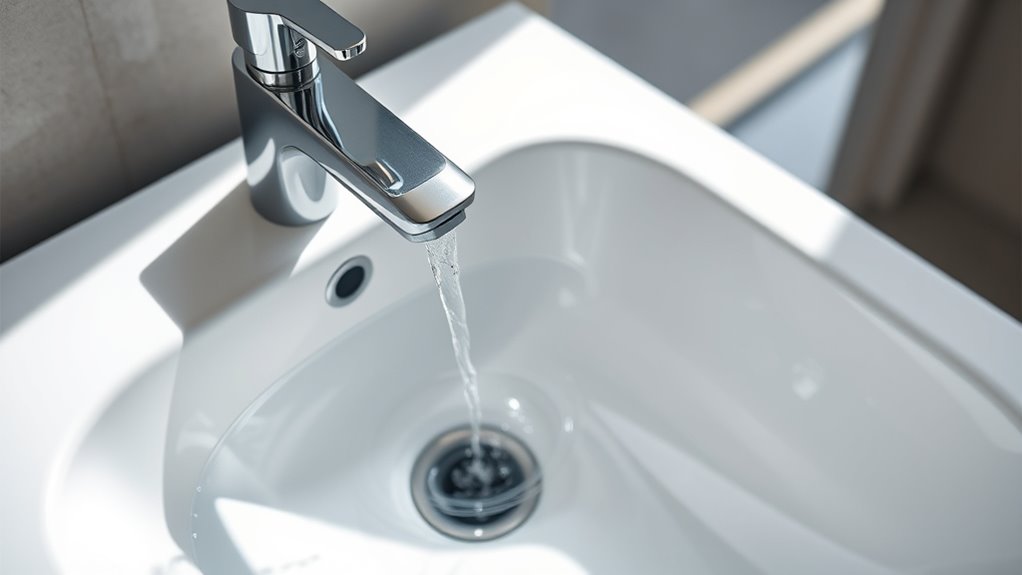
Are you looking for an easy way to reduce your water bills and conserve resources? Low-flow fixtures might be just what you need. These fixtures, including showerheads, faucets, and toilets, are designed to use considerably less water without sacrificing performance. While some people worry about the upfront costs, it’s important to weigh the installation costs versus the long term savings. Although low-flow fixtures can be more expensive initially, they pay off over time through lower water bills and reduced energy use for water heating.
Installing low-flow fixtures is a straightforward process, especially if your current fixtures are outdated or high-volume. The installation costs are generally minimal if you do it yourself or hire a professional. Many fixtures are designed to be compatible with existing plumbing, which keeps installation simple and affordable. In some cases, replacing all your fixtures can be completed in a weekend, making it a manageable upgrade. Keep in mind that the initial investment varies depending on the quality and brand of the fixtures, but most homeowners find the costs reasonable given the potential savings.
Installing low-flow fixtures is simple and affordable, often doable in a weekend with minimal costs.
Once installed, low-flow fixtures make a noticeable difference in water consumption. For instance, a standard showerhead uses about 2.5 gallons per minute, whereas a low-flow showerhead may use only 1.5 gallons. Over time, this reduction adds up—especially if you take long showers or have multiple family members. Similarly, low-flow toilets use up to 50% less water than older models, which means less water wasted with each flush. These savings can greatly cut your monthly water bill, especially in areas with high water rates.
Beyond just saving water, low-flow fixtures also save energy. Heating water accounts for a large part of your energy bill, so reducing water consumption means less demand on your water heater. Over the long term, these energy savings amplify your overall cost benefits. Many utility companies also offer rebates or incentives for installing water-efficient fixtures, which can offset the initial purchase and installation costs. Incorporating water-efficient technology into your home can further enhance these savings by maximizing resource conservation.
In the end, low-flow fixtures are a smart investment for any homeowner looking to lower bills and lessen their environmental impact. The initial costs are relatively low, and the long term savings are substantial. You’ll not only enjoy reduced utility bills but also contribute to water conservation efforts without sacrificing comfort. It’s a simple, effective step toward more sustainable living that pays off in both savings and peace of mind.
Frequently Asked Questions
Do Low-Flow Fixtures Affect Water Pressure Significantly?
You might wonder if low-flow fixtures impact water pressure. Usually, they don’t substantially affect it if they’re compatible with your plumbing system. Proper fixture compatibility ensures water flows smoothly, maintaining good pressure. However, if your pipes are old or narrow, you could notice some pressure reduction. To avoid this, choose fixtures designed for your system and consider consulting a plumber for ideal installation.
Are Low-Flow Fixtures Compatible With All Plumbing Systems?
Sure, low-flow fixtures are compatible with most plumbing systems, right? Well, not exactly. You might face some installation challenges if your pipes are old or tricky, making the upgrade less seamless. Plus, don’t forget aesthetic considerations—some models might not match your bathroom’s style. Before jumping in, check your plumbing setup and choose fixtures that blend well, or you might end up with a water-saving headache.
How Long Do Low-Flow Fixtures Typically Last?
You might wonder how long low-flow fixtures last. Typically, their fixture durability ranges from 5 to 15 years, depending on usage and water quality. Investing in high-quality fixtures can reduce replacement costs over time. Regular maintenance helps prolong their lifespan, so you save money and avoid early replacements. Overall, choosing durable fixtures ensures you get the most out of your investment while enjoying water efficiency.
Are There Any Health Concerns With Using Low-Flow Fixtures?
You might wonder about health concerns related to water quality when using low-flow fixtures. Generally, these fixtures don’t pose health risks, as they meet safety standards. However, if water stays stagnant or the system isn’t maintained properly, bacteria or mold could develop, affecting water quality. To stay safe, regularly clean fixtures and monitor water flow, ensuring your water remains healthy and safe to use.
Do Low-Flow Fixtures Lead to Higher Energy Costs?
You might wonder if low-flow fixtures increase energy costs. While they primarily promote water conservation, they can also impact energy use since less hot water is needed, reducing energy for water heating. This means you could see lower energy impact along with water savings. Overall, low-flow fixtures often help you save money on both water and energy, making them a smart choice for eco-conscious households.
Conclusion
So, you might be surprised to learn that switching to low-flow fixtures can cut your water use by up to 30%. That means saving thousands of gallons each year—that’s enough to fill a small swimming pool! With such a big impact, it’s clear these fixtures aren’t just about saving water; they’re about making a real difference for your wallet and the environment. So, why not make the switch and start saving today?
